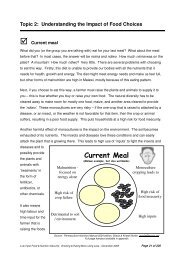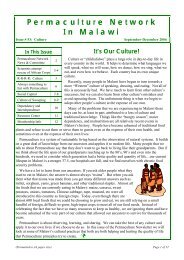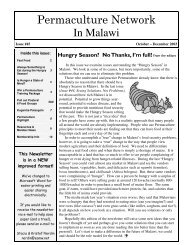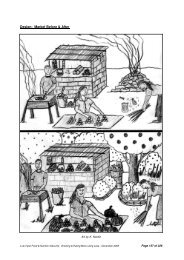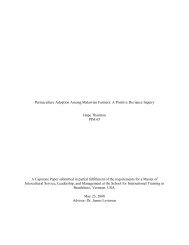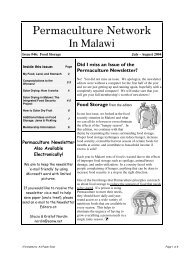Harmonisation of seed laws in Africa.indd - Never Ending Food
Harmonisation of seed laws in Africa.indd - Never Ending Food
Harmonisation of seed laws in Africa.indd - Never Ending Food
You also want an ePaper? Increase the reach of your titles
YUMPU automatically turns print PDFs into web optimized ePapers that Google loves.
GRICULTURE, ENERGY AND LIVELIHOOD SERIES<br />
that GM technologies have potential, but robust legal, production and distribution systems, and<br />
that greater access <strong>of</strong> farmers to agri-chemicals and markets, are prerequisites for the eventual,<br />
successful adoption <strong>of</strong> GM <strong>seed</strong>.<br />
Seed production<br />
<strong>Africa</strong>n <strong>seed</strong> systems have generally existed outside global circuits <strong>of</strong> capitalist accumulation apart<br />
from some enclaves or niches developed dur<strong>in</strong>g the colonial era. The focus <strong>of</strong> these enclaves was<br />
on commercially viable crops, especially for export as part <strong>of</strong> the colonial system <strong>of</strong> extraction.<br />
Accord<strong>in</strong>g to the International Centre for Tropical Agriculture (CIAT), 80 - 90 per cent <strong>of</strong> the world’s<br />
<strong>seed</strong> stocks are provided through what they call the ‘<strong>in</strong>formal’ <strong>seed</strong> system, and <strong>Africa</strong> is no<br />
exception. 4 More than 80 per cent <strong>of</strong> all <strong>seed</strong> <strong>in</strong> <strong>Africa</strong> is still produced and dissem<strong>in</strong>ated <strong>in</strong>formally. 5<br />
Consequently, <strong>Africa</strong> and the Middle East constituted just 2.7 per cent <strong>of</strong> the global commercial <strong>seed</strong><br />
market <strong>in</strong> 2007. 6<br />
Farmer-controlled <strong>seed</strong> systems <strong>in</strong> <strong>Africa</strong> are <strong>in</strong>tegrated and locally organised. They are based on<br />
the ways farmers themselves produce, dissem<strong>in</strong>ate and procure <strong>seed</strong>s through on-farm sav<strong>in</strong>g and<br />
exchange with neighbours and others. 7 This is connected to food supply and distribution systems,<br />
for example through the use <strong>of</strong> a maize harvest for a comb<strong>in</strong>ation <strong>of</strong> food, feed and plant<strong>in</strong>g.<br />
The harvest<strong>in</strong>g <strong>of</strong> <strong>seed</strong> from preferred plants is the basis <strong>of</strong> crop domestication over the 10 000<br />
years <strong>of</strong> agriculture. This has led La Via Campes<strong>in</strong>a to say that ‘all <strong>in</strong>dustrial <strong>seed</strong>s are the product <strong>of</strong><br />
thousands <strong>of</strong> years <strong>of</strong> selection and breed<strong>in</strong>g by our peoples’. 8 Exploitation <strong>of</strong> chance mutations and<br />
natural selection processes were the ma<strong>in</strong> form <strong>of</strong> plant improvement for most <strong>of</strong> this time until the<br />
last 80 - 100 years. The development <strong>of</strong> the science <strong>of</strong> genetics at the end <strong>of</strong> the n<strong>in</strong>eteenth century<br />
led to the rise <strong>of</strong> scientific research <strong>in</strong>to the <strong>in</strong>heritance <strong>of</strong> traits <strong>in</strong> plants and crops. After 1945,<br />
other advances <strong>in</strong> science such as <strong>in</strong> vitro technologies and mutagenisis led to the development <strong>of</strong><br />
‘high-yield<strong>in</strong>g’ <strong>seed</strong> varieties. 9 Later genetic modification (GM) and molecular markers extended<br />
these technologies further. About half <strong>of</strong> the yield ga<strong>in</strong>s s<strong>in</strong>ce the 1940s are attributed to genetic<br />
improvements by plant breeders, and the other half to mechanisation, irrigation and chemicals. 10<br />
Commercial <strong>seed</strong> firms and private breeders only emerged <strong>in</strong> the 1930s. Prior to that, farmers saved<br />
<strong>seed</strong> from their own crops and governments funded plant breed<strong>in</strong>g research and development<br />
(R&D). The development <strong>of</strong> hybrids – cross-poll<strong>in</strong>at<strong>in</strong>g crops, such as maize – set the <strong>seed</strong> <strong>in</strong>dustry<br />
on a completely new trajectory. Hybrid <strong>seed</strong>s were developed from the 1920s for maize <strong>in</strong> the US<br />
(<strong>of</strong> which Pioneer Hi-Bred was literally the pioneer), and later for other crops, to cross desired traits<br />
identified <strong>in</strong> different varieties <strong>in</strong>to a s<strong>in</strong>gle plant.<br />
Hybrid <strong>seed</strong>s<br />
Hybrid <strong>seed</strong>s are produced from naturally out-breed<strong>in</strong>g crops, from which <strong>in</strong>bred l<strong>in</strong>es are produced<br />
by repeated self-poll<strong>in</strong>ation. 11 F1 hybrids refer to agricultural cultivars derived from two different<br />
parent cultivars, which are first <strong>in</strong>bred for selected characteristics (e.g. early maturity, diseaseresistance<br />
or drought-tolerance) and then crossed with one another and evaluated for yield<br />
potential and other desired characteristics. 12 Crosses between two unrelated parents are known<br />
as s<strong>in</strong>gle crosses. Those from three parents are known as three-way hybrids, and those from four<br />
parents are double-cross hybrids. The female product <strong>of</strong> a three-way hybrid is a s<strong>in</strong>gle-cross hybrid<br />
and the male is an <strong>in</strong>bred l<strong>in</strong>e. The parents <strong>of</strong> a double-cross hybrid are both s<strong>in</strong>gle-cross hybrids<br />
<strong>Harmonisation</strong> <strong>of</strong> <strong>Africa</strong>’s <strong>seed</strong>s <strong>laws</strong>: a recipe for disaster 9



